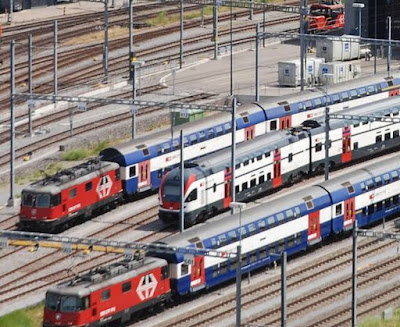Zurich, The City
Zurich is the largest city in Switzerland. It dates from Roman times ...... shown in an artist's "imagining" looking south (ish) towards the lake.
Like many places that eventually came together to form the Swiss Federation, Zurich had its fair share of wars with various peoples, including armies from other bits of Switzerland.
And the lake and the river?
Today's city is not too huge, a little over 440,000 souls i.e. just a bit smaller than Liverpool. "Greater" urban Zurich has a population of about 1.3 million and the Canton (its political and administrative area) about 1.8 million.
Zurich stands on the River Limmat which joins the lake, called, with an original name, the Zurichsee (Zurich Lake!).
The lake is quite big ...... and criss-crossed by a multitude of ferries ...... some for cars etc.Nearby is a cable car!The main passenger transport in the urban area is, as you would expect, the tram.There are buses of various kinds ...... and trolleybuses which are amazing! This short video (4 mins) is well worth a look.There is a lot of bus running off the trolley which powers the wheels at the back. So the engine pushes the segments of the articulated bus. This is fairly standard practice in Europe and elsewhere, but seems quite scary to a staid and stolid Brit, familiar with something a little shorter.
There is a very extensive S-Bahn network although most services are less frequent than in some cities.Maybe think Network SouthEast rather than Overground or Elizabeth Line line! The route map gives a quick impression of the network ...... but a look at the heavy rail junctions to the west of Zurich Hauptbahnhof will give you a better idea,So what we need is a good network map.
Well, there isn't one - there are many!
Here is an extract from the map that shows S-Bahn (in colours) and selected buses ...... an extract showing the area round the central station. Yikes!
Then there is the tram, trolleybus and bus map - mainly tram and trolley in the centre of the city.Once again, note the "knitting" round the main station. Yikes again.
And there's more. Here are two maps of services on the water, first on Zurichsee itself ...... and with a bit more detail at the confluence with the Limmat river.To add to the fun, there are a few suburban maps, this sample being of the area round the airport (Flughafen).Trams 10 (PUCE) and 12 (PALE BLUE) intermingle with buses in multiple shades of blue from pale to paler, to even paler to very pale indeed.
Confused.com
So, yet again without the use of a safety net, fbb will try to unravel this simply amazing transport network. Tomorrow we will begin with the trams and, by way of introduction, enjoy another 4 minute video giving an overview of what constitutes a Zurich tram in recent years.
Note that all of the video shows trams in the centre and running happily on the street mixed with cars, buses and people. How is this ever possible though stringent safety precautions.Good, innit?
Snippet
Thanks to Northampton Alan for a picture of three Todmorden buses at a recent rally. (See yesterday's blog).
It Happened!
The Hornby programme did appear yesterday on Yesterday. The main content was all about creating Flying Scotsman in the new TT120 scale ...... with the team eagerly awaiting a sample in its proper colours!
A sub-story was of the challenge of repairing a couple of busted "Rocket" models.Even for the professional repairer, the job is mega fiddly!
Rather he than fbb!
The loco and coaches featured in the programme are all now available. Some idea of the smaller scale can be gathered from the model "in hand".
Next Zurich TRAM blog : Wednesday 18th January

























The Todmorden JOC joined forces with the Halifax JOC to form the Calderdale JOC in 1971, this was 50% owned by the National Bus Company which had taken over the railway shares of the JOCs in 1968. All the staff however were employed by Halifax Corporation. This led to Hebble's Halifax routes being offered to the new Calderdale JOC later in 1971. The NBC gave notice to withdraw from the Calderdale JOC prior to the formation of the West Yorkshire PTE (Passenger Transport Executive) on 1st April 1974.
ReplyDeleteOne benefit of the merger was through services for the Calder Valley from Halifax via Hebden Bridge and Todmorden to Burnley and Littleborough (later Rochdale).
Having perused the Interweb, I'm pretty sure that the Citaro bendy-buses as used in London, Cardiff and elsewhere drove on the rear axle. Mercedes on their website make quite a thing of the technology involved to keep things stable. And of course we've had "pusher" trains ever since the 1967 Bournemouth electrification - with some hesitation at first (and the Polmont rail crash of 1984, when a train hit a cow, showed what can happen if a heavy locomotive at the back isn't braked as efficiently as the carriages in front of it).
ReplyDeleteYes, you are right Andrew - all low floor diesel artics "push from the back". But the three section trolleys in the video have axles 2 and 3 powered, leaving axles 1 and 4 for steering.
Delete